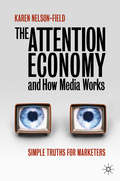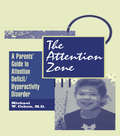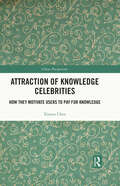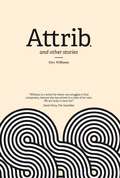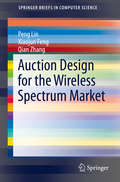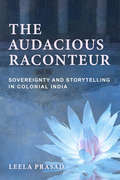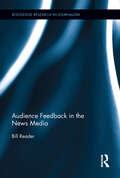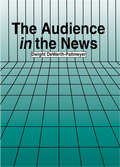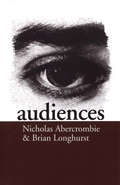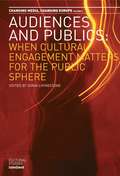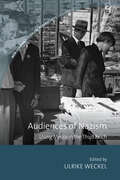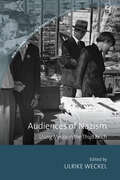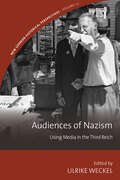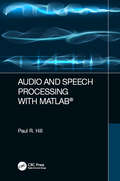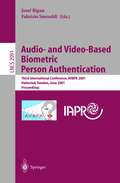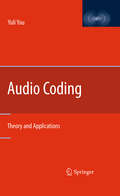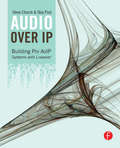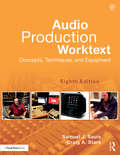- Table View
- List View
The Attention Economy and How Media Works: Simple Truths for Marketers
by Karen Nelson-FieldThis book offers a considered voice on the advertising chaos that colours our rapidly changing media environment in a world of fake news, fast facts and seriously depleted attention stamina. Rather than simply herald disruption, Karen Nelson-Field starts an intelligent conversation on what it will take for businesses to win in an attention economy, the advertising myths we need to leave behind and the scientific evidence we can use to navigate a complex advertising and media ecosystem. This book makes sense of viewability standards, coverage and clutter; it talks about the real quality behind a qCPM and takes a deep dive into the relationship between attention and sales. It explains the stark reality of human attention processing in advertising. Readers will learn how to maximise a viewer’s divided attention by leveraging specific media attributes and using attention-grabbing creative triggers. Nelson-Field asks you to pay attention to a disrupted advertising future without panic, but rather with a keen eye on the things that brand owners can learn to control.
The Attention Zone: A Parent's Guide To Attention Deficit/Hyperactivity
by Michael CohenFirst published in 1998. Routledge is an imprint of Taylor & Francis, an informa company.
The Attention Zone: A Parent's Guide To Attention Deficit/Hyperactivity
by Michael CohenFirst published in 1998. Routledge is an imprint of Taylor & Francis, an informa company.
Attraction of Knowledge Celebrities: How They Motivate Users to Pay for Knowledge (China Perspectives)
by Xiaoyu ChenThis book examines the phenomenon of knowledge celebrities, an emerging group of social media influencers who produce and sell knowledge products online. Its primary goal is to investigate the reasons and strategies behind their ability to attract users and persuade them to purchase knowledge products on digital platforms. With the increasing demand for high-quality content from online users, various platforms have emerged as pay-for-knowledge platforms, allowing knowledge celebrities to monetize their expertise. This book draws on theoretical frameworks from information science, communication, and management to provide insights into this phenomenon and to examine the practices and individuals involved. Building on existing scholarship and analyzing case studies in China, this book presents the background, basic concepts, and understanding of knowledge celebrities. It then explores the three key factors that contribute to the attractiveness of knowledge celebrities, as well as the motivations and mechanisms behind pay-for-knowledge practices. Finally, the book offers a glimpse into the future landscape of knowledge celebrities and pay-for-knowledge platforms. The book will be valuable to scholars, students, and practitioners in information, communication, and media studies. In particular, it will appeal to those interested in topics such as knowledge celebrities, the creator economy, and knowledge management.
Attraction of Knowledge Celebrities: How They Motivate Users to Pay for Knowledge (China Perspectives)
by Xiaoyu ChenThis book examines the phenomenon of knowledge celebrities, an emerging group of social media influencers who produce and sell knowledge products online. Its primary goal is to investigate the reasons and strategies behind their ability to attract users and persuade them to purchase knowledge products on digital platforms. With the increasing demand for high-quality content from online users, various platforms have emerged as pay-for-knowledge platforms, allowing knowledge celebrities to monetize their expertise. This book draws on theoretical frameworks from information science, communication, and management to provide insights into this phenomenon and to examine the practices and individuals involved. Building on existing scholarship and analyzing case studies in China, this book presents the background, basic concepts, and understanding of knowledge celebrities. It then explores the three key factors that contribute to the attractiveness of knowledge celebrities, as well as the motivations and mechanisms behind pay-for-knowledge practices. Finally, the book offers a glimpse into the future landscape of knowledge celebrities and pay-for-knowledge platforms. The book will be valuable to scholars, students, and practitioners in information, communication, and media studies. In particular, it will appeal to those interested in topics such as knowledge celebrities, the creator economy, and knowledge management.
Attrib. and Other Stories (PDF)
by Eley WilliamsThis debut collection from Eley Williams centres upon the difficulties of communication and the way one's thoughts may never be fully communicable and yet can overwhelm you. Attrib. celebrates the tricksiness of language just as it confronts its limits. Correspondingly, the stories are littered with the physical ephemera of language: dictionaries, dog-eared pages, bookmarks and old coffee stains on older books. This is writing that centres on the weird, tender intricacies of the everyday. A bold new collection from one of Britain's most original new writers.
Auction Design for the Wireless Spectrum Market (SpringerBriefs in Computer Science)
by Peng Lin Xiaojun Feng Qian ZhangThis Brief introduces the wireless spectrum market and discusses the current research for spectrum auctions. It covers the unique properties of spectrum auction, such as interference relationship, reusability, divisibility, composite effect and marginal effect, while also proposing how to build economic incentives into the network architecture and protocols in order to optimize the efficiency of wireless systems. Three scenarios for designing new auctions are demonstrated. First, a truthful double auction scheme for spectrum trading considering both the heterogeneous propagation properties of channels and spatial reuse is proposed. In the second scenario, a framework is designed to enable spectrum group secondary users with a limited budget. Finally, a flexible auction is created enabling operators to purchase the right amounts of spectrum at the right prices according to their users’ dynamic demands. Both concise and comprehensive, Auction Design for the Wireless Spectrum Market is suited for professionals and researchers working with wireless communications and networks. It is also a useful tool for advanced-level students interested in spectrum and networking issues.
The Audacious Raconteur: Sovereignty and Storytelling in Colonial India
by Leela PrasadCan a subject be sovereign in a hegemony? Can creativity be reined in by forces of empire? Studying closely the oral narrations and writings of four Indian authors in colonial India, The Audacious Raconteur argues that even the most hegemonic circumstances cannot suppress "audacious raconteurs": skilled storytellers who fashion narrative spaces that allow themselves to remain sovereign and beyond subjugation. By drawing attention to the vigorous orality, maverick use of photography, literary ventriloquism, and bilingualism in the narratives of these raconteurs, Leela Prasad shows how the ideological bulwark of colonialism—formed by concepts of colonial modernity, history, science, and native knowledge—is dismantled. Audacious raconteurs wrest back meanings of religion, culture, and history that are closer to their lived understandings. The figure of the audacious raconteur does not only hover in an archive but suffuses everyday life. Underlying these ideas, Prasad's personal interactions with the narrators' descendants give weight to her innovative argument that the audacious raconteur is a necessary ethical and artistic figure in human experience.Thanks to generous funding from Duke University, the ebook editions of this book are available as Open Access volumes from Cornell Open (cornellopen.org) and other repositories.
Audience Feedback in the News Media (Routledge Research in Journalism)
by Bill ReaderAs long as there has been news media, there has been audience feedback. This book provides the first definitive history of the evolution of audience feedback, from the early newsbooks of the 16th century to the rough-and-tumble online forums of the modern age. In addition to tracing the historical development of audience feedback, the book considers how news media has changed its approach to accommodating audience participation, and explores how audience feedback can serve the needs of both individuals and collectives in democratic society. Reader writes from a position of authority, having worked as a "letters to the editor" editor and has written numerous research articles and professional essays on the topic over the past 15 years.
Audience Feedback in the News Media (Routledge Research in Journalism)
by Bill ReaderAs long as there has been news media, there has been audience feedback. This book provides the first definitive history of the evolution of audience feedback, from the early newsbooks of the 16th century to the rough-and-tumble online forums of the modern age. In addition to tracing the historical development of audience feedback, the book considers how news media has changed its approach to accommodating audience participation, and explores how audience feedback can serve the needs of both individuals and collectives in democratic society. Reader writes from a position of authority, having worked as a "letters to the editor" editor and has written numerous research articles and professional essays on the topic over the past 15 years.
The Audience in the News (Routledge Communication Series)
by Dwight DeWerth-PallmeyerIn recent years, communication scholars have taken a renewed interest in analyzing the audience and its impact on the communication process. Similarly, news editors and producers have often turned toward a marketing orientation which seeks to give new readers and viewers what they want, or at least what they say they want. Yet, there has still been little written about just how the audience factors into the news which is produced. Seeking to fill that niche, this book argues that audience images are quite important in the construction of news, but not easily detected. That is because journalists are not principally interested in their audience; they are interested in the news. USE THIS PARAGRAPH ONLY FOR GENERAL CATALOGS... This volume argues that although journalistic images of the audience may be "incomplete," they do exist and powerfully help shape the work of journalists in producing journalistic texts. Using a case study of news workers and news texts at two Chicago newsgathering organizations, the Chicago Tribune and WGN-TV, this book: * examines notions of audience and how they have been treated by academicians, * presents a detailed description of the ways in which audience is embedded within the news construction process, * presents a very representative set of journalistic news values, * presents differing ideas of audience at three key levels of the news organizations -- reporters and news gatherers, editors and producers, and senior editors, producers, and news directors, and * seeks to summarize and position this study within the larger body of mass communication research.
The Audience in the News (Routledge Communication Series)
by Dwight DeWerth-PallmeyerIn recent years, communication scholars have taken a renewed interest in analyzing the audience and its impact on the communication process. Similarly, news editors and producers have often turned toward a marketing orientation which seeks to give new readers and viewers what they want, or at least what they say they want. Yet, there has still been little written about just how the audience factors into the news which is produced. Seeking to fill that niche, this book argues that audience images are quite important in the construction of news, but not easily detected. That is because journalists are not principally interested in their audience; they are interested in the news. USE THIS PARAGRAPH ONLY FOR GENERAL CATALOGS... This volume argues that although journalistic images of the audience may be "incomplete," they do exist and powerfully help shape the work of journalists in producing journalistic texts. Using a case study of news workers and news texts at two Chicago newsgathering organizations, the Chicago Tribune and WGN-TV, this book: * examines notions of audience and how they have been treated by academicians, * presents a detailed description of the ways in which audience is embedded within the news construction process, * presents a very representative set of journalistic news values, * presents differing ideas of audience at three key levels of the news organizations -- reporters and news gatherers, editors and producers, and senior editors, producers, and news directors, and * seeks to summarize and position this study within the larger body of mass communication research.
Audiences: A Sociological Theory of Performance and Imagination (PDF)
by Dr Brian Longhurst Professor Nick Abercrombie`This book is worth reading for a number of reasons. It is the first introductory work of critical audience research that suggests how we can study the connection of media consumption in general with every day life, and it also goes beyond its competitors in showing how postmodern thinking can help us in the analysis of a "whole way of life"' - Journal of Communication Audiences are problematic and the study of audiences has represented a key site of activity in the social sciences and humanities. Offering a timely review of the past 50 years of theoretical and methodological debate Audiences argues the case for a paradigmatic shift in audience research. This shift, argue the authors, is necessitated by the emergence of the `diffused audience'. Audience experience can no longer be simply classified as `simple' or `mass', for in modern advanced capitalist societies, people are members of an audience all the time. Being a member of an audience is no longer an exceptional event, nor even an everyday event, rather it is constitutive of everyday life. This book offers an invaluable review of the literature and a new point of departure for audience research.
Audiences And Publics: When Cultural Engagement Matters For The Public Sphere (Intellect Books - Changing Media, Changing Europe Ser. #Vol. 2)
by Sonia LivingstoneIn today’s thoroughly mass-mediated world, audiences and publics are, of course, composed of the same people. Yet social science traditionally treats them quite differently. Indeed, it is commonplace to define audiences in opposition to the public: in both popular and elite discourses, audiences are denigrated as trivial, passive, individualised, while publics are valued as active, critically engaged and politically significant.
Audiences of Nazism: Using Media in the Third Reich (New German Historical Perspectives #13)
by Ulrike WeckelThrough its focus on audiences and their reception of media in Nazi Germany, Audiences of Nazism inverts the typical top-down perspective employed in studies that concentrate on the regime’s regulation of media and propaganda. It thereby sheds new light on the complex character of the period’s media, their uses, and the scope for audience interpretation. Contributors investigate how consumers either appropriated or ignored certain messages of Nazi propaganda, and how some even participated in its production. The authors ground their studies on novel historical sources, including private diaries and letters, photographs and films, and concert programs, which demonstrate, amongst other things, how audiences interpreted and responded to regulated news, Nazi Party rallies, and the regime’s denunciation of modern works of art as ‘degenerate.’
Audiences of Nazism: Using Media in the Third Reich (New German Historical Perspectives #13)
by Ulrike WeckelThrough its focus on audiences and their reception of media in Nazi Germany, Audiences of Nazism inverts the typical top-down perspective employed in studies that concentrate on the regime’s regulation of media and propaganda. It thereby sheds new light on the complex character of the period’s media, their uses, and the scope for audience interpretation. Contributors investigate how consumers either appropriated or ignored certain messages of Nazi propaganda, and how some even participated in its production. The authors ground their studies on novel historical sources, including private diaries and letters, photographs and films, and concert programs, which demonstrate, amongst other things, how audiences interpreted and responded to regulated news, Nazi Party rallies, and the regime’s denunciation of modern works of art as ‘degenerate.’
Audiences of Nazism: Using Media in the Third Reich (New German Historical Perspectives #13)
Through its focus on audiences and their reception of media in Nazi Germany, Audiences of Nazism inverts the typical top-down perspective employed in studies that concentrate on the regime’s regulation of media and propaganda. It thereby sheds new light on the complex character of the period’s media, their uses, and the scope for audience interpretation. Contributors investigate how consumers either appropriated or ignored certain messages of Nazi propaganda, and how some even participated in its production. The authors ground their studies on novel historical sources, including private diaries and letters, photographs and films, and concert programs, which demonstrate, amongst other things, how audiences interpreted and responded to regulated news, Nazi Party rallies, and the regime’s denunciation of modern works of art as ‘degenerate.’
Audio and Speech Processing with MATLAB
by Paul HillSpeech and audio processing has undergone a revolution in preceding decades that has accelerated in the last few years generating game-changing technologies such as truly successful speech recognition systems; a goal that had remained out of reach until very recently. This book gives the reader a comprehensive overview of such contemporary speech and audio processing techniques with an emphasis on practical implementations and illustrations using MATLAB code. Core concepts are firstly covered giving an introduction to the physics of audio and vibration together with their representations using complex numbers, Z transforms and frequency analysis transforms such as the FFT. Later chapters give a description of the human auditory system and the fundamentals of psychoacoustics. Insights, results, and analyses given in these chapters are subsequently used as the basis of understanding of the middle section of the book covering: wideband audio compression (MP3 audio etc.), speech recognition and speech coding. The final chapter covers musical synthesis and applications describing methods such as (and giving MATLAB examples of) AM, FM and ring modulation techniques. This chapter gives a final example of the use of time-frequency modification to implement a so-called phase vocoder for time stretching (in MATLAB). Features A comprehensive overview of contemporary speech and audio processing techniques from perceptual and physical acoustic models to a thorough background in relevant digital signal processing techniques together with an exploration of speech and audio applications. A carefully paced progression of complexity of the described methods; building, in many cases, from first principles. Speech and wideband audio coding together with a description of associated standardised codecs (e.g. MP3, AAC and GSM). Speech recognition: Feature extraction (e.g. MFCC features), Hidden Markov Models (HMMs) and deep learning techniques such as Long Short-Time Memory (LSTM) methods. Book and computer-based problems at the end of each chapter. Contains numerous real-world examples backed up by many MATLAB functions and code.
Audio and Speech Processing with MATLAB
by Paul HillSpeech and audio processing has undergone a revolution in preceding decades that has accelerated in the last few years generating game-changing technologies such as truly successful speech recognition systems; a goal that had remained out of reach until very recently. This book gives the reader a comprehensive overview of such contemporary speech and audio processing techniques with an emphasis on practical implementations and illustrations using MATLAB code. Core concepts are firstly covered giving an introduction to the physics of audio and vibration together with their representations using complex numbers, Z transforms and frequency analysis transforms such as the FFT. Later chapters give a description of the human auditory system and the fundamentals of psychoacoustics. Insights, results, and analyses given in these chapters are subsequently used as the basis of understanding of the middle section of the book covering: wideband audio compression (MP3 audio etc.), speech recognition and speech coding. The final chapter covers musical synthesis and applications describing methods such as (and giving MATLAB examples of) AM, FM and ring modulation techniques. This chapter gives a final example of the use of time-frequency modification to implement a so-called phase vocoder for time stretching (in MATLAB). Features A comprehensive overview of contemporary speech and audio processing techniques from perceptual and physical acoustic models to a thorough background in relevant digital signal processing techniques together with an exploration of speech and audio applications. A carefully paced progression of complexity of the described methods; building, in many cases, from first principles. Speech and wideband audio coding together with a description of associated standardised codecs (e.g. MP3, AAC and GSM). Speech recognition: Feature extraction (e.g. MFCC features), Hidden Markov Models (HMMs) and deep learning techniques such as Long Short-Time Memory (LSTM) methods. Book and computer-based problems at the end of each chapter. Contains numerous real-world examples backed up by many MATLAB functions and code.
Audio- and Video-Based Biometric Person Authentication: Third International Conference, AVBPA 2001 Halmstad, Sweden, June 6-8, 2001. Proceedings (Lecture Notes in Computer Science #2091)
by Josef Bigun Fabrizio SmeraldiAudio Coding: Theory and Applications
by Yuli YouAudio Coding: Theory and Applications provides succinct coverage of audio coding technologies that are widely used in modern audio coding standards. Delivered from the perspective of an engineer, this book articulates how signal processing is used in the context of audio coding. It presents a detailed treatment of contemporary audio coding technologies and then uses the DRA audio coding standard as a practical example to illustrate how numerous technologies are integrated into a fully-fledged audio coding algorithm. Drawing upon years of practical experience and using numerous examples and illustrations Dr. Yuli You, gives a description of practical audio coding technologies including: • Designing high-performance algorithms that can be readily implemented on fixed-point or integer microprocessors. • How to properly implement an audio decoder on various microprocessors. Transient detection and adaptation of time-frequency resolution of subband filters. • Psychoacoustic models and optimal bit allocation. Audio Coding: Theory and Applications will be a valuable reference book for engineers in the consumer electronics industry, as well as students and researchers in electrical engineering.
Audio Over IP: Building Pro AoIP Systems with Livewire
by Steve Church Skip PizziPosition yourself at the forefront of audio and broadcast studio technology by learning audio over IP. You will gain knowledge of IP network engineering as it applies to audio applications, and then progress to a full understanding of how equipment built on Ethernet and Internet Protocol are used in today's audio production and broadcast facilities for the transporting, mixing and processing of pro-quality audio. A chapter on integrating Voice-over IP telephony (VoIP) to pro-audio and broadcast facilities is also included. Using the popular Livewire technology, you will learn how to design, construct, configure and troubleshoot an AoIP system, including how to interface with PCs, VoIP telephone PBXs, IP codecs, and the Internet. See how AoIP systems work in practice, and discover their distinct advantages over older audio infrastructures. With its complete introduction to AoIP technology in a fun, highly readable style, this book is essential for audio professionals who want to broaden their knowledge of IP-based studio systems--or for IT experts who need to understand AoIP applications.
Audio Over IP: Building Pro AoIP Systems with Livewire
by Steve Church Skip PizziPosition yourself at the forefront of audio and broadcast studio technology by learning audio over IP. You will gain knowledge of IP network engineering as it applies to audio applications, and then progress to a full understanding of how equipment built on Ethernet and Internet Protocol are used in today's audio production and broadcast facilities for the transporting, mixing and processing of pro-quality audio. A chapter on integrating Voice-over IP telephony (VoIP) to pro-audio and broadcast facilities is also included. Using the popular Livewire technology, you will learn how to design, construct, configure and troubleshoot an AoIP system, including how to interface with PCs, VoIP telephone PBXs, IP codecs, and the Internet. See how AoIP systems work in practice, and discover their distinct advantages over older audio infrastructures. With its complete introduction to AoIP technology in a fun, highly readable style, this book is essential for audio professionals who want to broaden their knowledge of IP-based studio systems--or for IT experts who need to understand AoIP applications.
Audio Production Worktext: Concepts, Techniques, and Equipment
by Samuel J. Sauls Craig A. StarkThis is an excellent introduction to the modern radio production studio, the equipment found in that studio, and the basic techniques needed to accomplish radio production work. The new edition is updated throughout and features new sections on mobile technology, audio editing apps and software, and digital editing, as well as updated graphics and expanded content on portable digital audio players. Features a worktext/website format tailored for both students and teachers, offering a solid foundation for anyone who wishes to know more about radio/audio equipment and production techniques.
Audio Production Worktext: Concepts, Techniques, and Equipment
by Samuel J. Sauls Craig A. StarkThis is an excellent introduction to the modern radio production studio, the equipment found in that studio, and the basic techniques needed to accomplish radio production work. The new edition is updated throughout and features new sections on mobile technology, audio editing apps and software, and digital editing, as well as updated graphics and expanded content on portable digital audio players. Features a worktext/website format tailored for both students and teachers, offering a solid foundation for anyone who wishes to know more about radio/audio equipment and production techniques.
